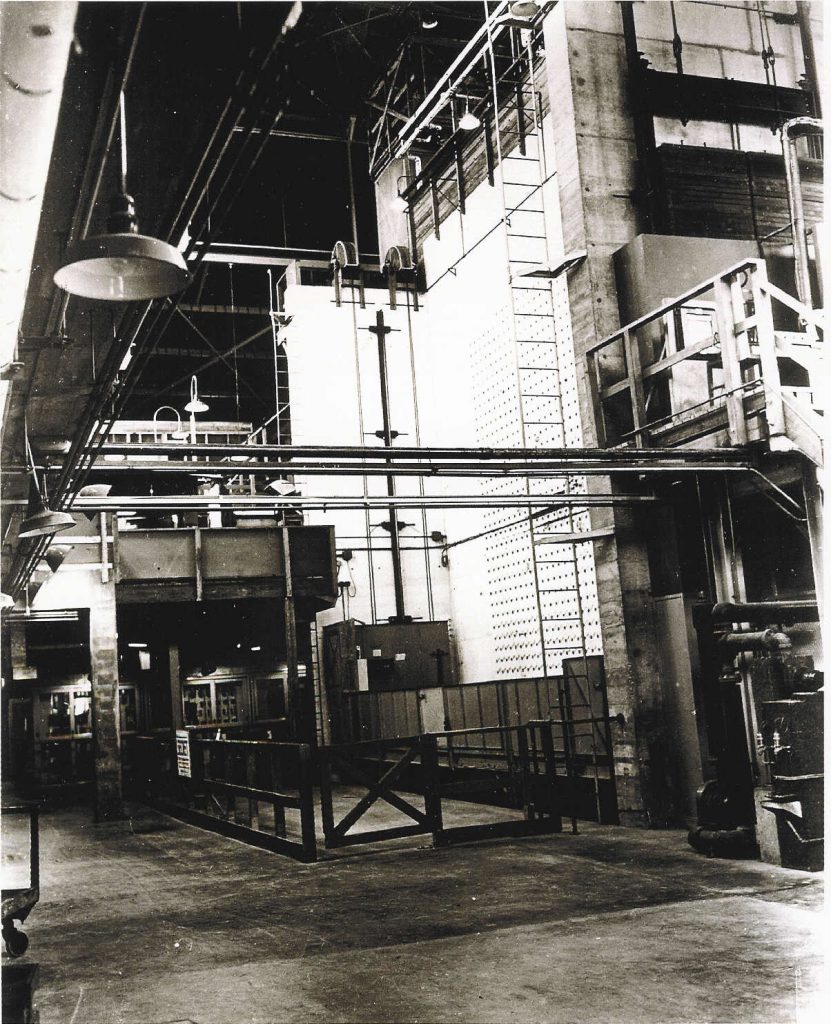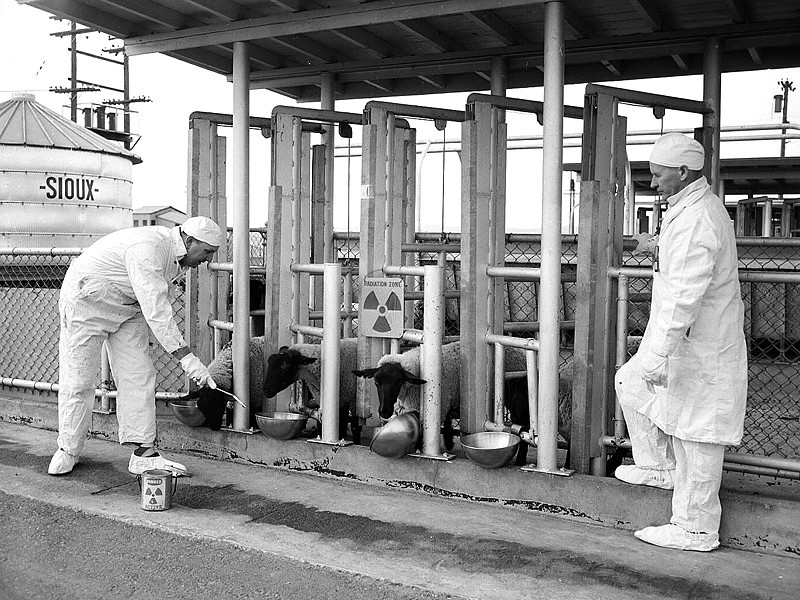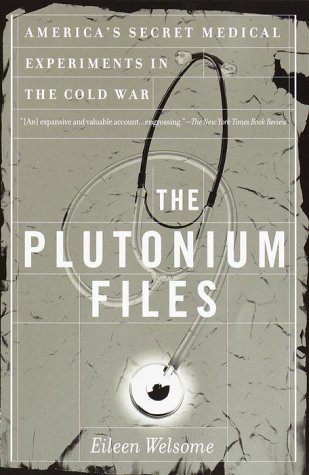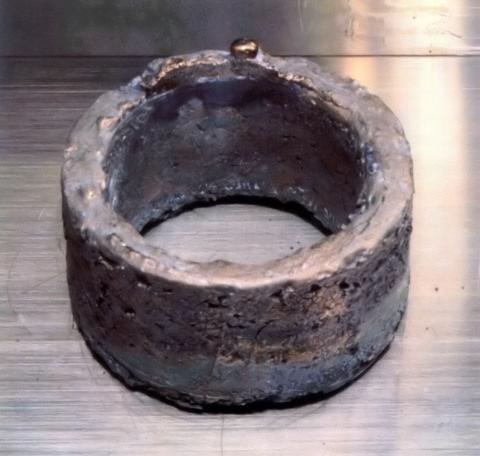Element 94
Plutonium was a new and unusual substance. Its discovery created unique opportunities and challenges for scientists and corporate partners of the Manhattan Project.
Plutonium was first produced and isolated on December 14, 1940 by Dr. Glenn T. Seaborg, Joseph W. Kennedy, Edwin M. McMillan, and Arthur C. Wahl by deuteron bombardment of uranium in the 60-inch cyclotron at the University of California, Berkeley. An article explaining the discovery was prepared by the team and sent to the Physical Review to be published in March 1941, but the paper was withdrawn after the subsequent discovery that an isotope of the new element, plutonium-239, could undergo fission and be used as fuel for an atomic bomb.
The basic chemistry of plutonium is closely related to uranium. Early on, scientists realized that a slow neutron reactor fueled with uranium could theoretically produce significant amounts of plutonium-239 as a by-product. This is because uranium-238 absorbs slow neutrons and forms a new isotope, U-239, whose nucleus rapidly emits an electrons producing a new element with a mass of 239 and an atomic number of 93. This element’s nucleus then also emits an electron and becomes a new element of mass 239 but with an atomic number 94 and a much greater half-life. This meant that element 94 would be “fissionable” by both slow and fast neutrons and since it was chemically different from uranium, it could easily be separated from it.
Early research on plutonium was carried out secretly at the University of Chicago’s Metallurgical Laboratory. A trace quantity of plutonium was isolated and measured for the first time on August 20, 1942. During this time, the nuclear properties of plutonium-239 were also studied. Scientists discovered that when neutrons hit the isotope, it fissions, releasing more neutrons and energy. As these neutrons hit other atoms of plutonium-239, an exponentially fast chain reaction is produced.
Plutonium Production
 Plutonium production was essential for the Manhattan Project, and scientists at institutions throughout the country were competing with isotope separation methods to create it during 1942. The first production reactor that made plutonium-239 was the X-10 Graphite Reactor, also known as the Clinton Pile, which went online in 1943 in Oak Ridge, TN. Emilio Segre, who was working on plutonium fission at Los Alamos, received the first sample of reactor-produced plutonium from Oak Ridge on April 5, 1944.
Plutonium production was essential for the Manhattan Project, and scientists at institutions throughout the country were competing with isotope separation methods to create it during 1942. The first production reactor that made plutonium-239 was the X-10 Graphite Reactor, also known as the Clinton Pile, which went online in 1943 in Oak Ridge, TN. Emilio Segre, who was working on plutonium fission at Los Alamos, received the first sample of reactor-produced plutonium from Oak Ridge on April 5, 1944.
With this small sample of plutonium, Segre was able to determine that reactor-bred plutonium had a higher concentration of the isotope plutonium-240 than cyclotron-produced plutonium. Since plutonium-240 has a high spontaneous fission rate, the original gun-type plutonium weapon, code-named “Thin Man”, had to be abandoned as a result (the increased number of spontaneous neutrons meant that nuclear pre-detonation fizzle would be likely).
This discovery meant that the entire plutonium weapon design effort at Los Alamos had to be altered to a more complicated implosion device, code-named “Fat Man.” The implosion design would use a series of explosive lenses to compress a solid sphere of plutonium-239 into a high-density core, initiating a nuclear chain reaction. Before physicists at Los Alamos could test the implosion design, they needed more plutonium for experiments.
In October 1943, construction began on a revolutionary plutonium production reactor in Hanford, WA. The B Reactor, as it came to known, was completed in March 1945 and began producing plutonium for the implosion-type atomic bomb.
The technology conceived during Fermi’s pile experiment continued to develop, yet it was not guaranteed to be a success. As late as 1945, scientists doubted the plutonium-based implosion bomb design would work, and there were immense challenges to successful construction. Therefore, to save the plutonium if a test failed, they created the Concrete Bowl. This 200-foot diameter bowl was tested with depleted uranium, and would recover plutonium should the experiment go awry.
The Biological Consequences of Plutonium
 Plutonium was a new material during the Manhattan Project, and scientists did not know much about the radioactive substance. Therefore, biochemists began working on understanding the harmful effects of radiation on the human body and what level of exposure would constitute a “tolerable” dose. MED officials needed to know when to remove a worker from the job if and when it was determined he had received an internal dose of radiation that was close to or over the limit of what was considered safe.
Plutonium was a new material during the Manhattan Project, and scientists did not know much about the radioactive substance. Therefore, biochemists began working on understanding the harmful effects of radiation on the human body and what level of exposure would constitute a “tolerable” dose. MED officials needed to know when to remove a worker from the job if and when it was determined he had received an internal dose of radiation that was close to or over the limit of what was considered safe.
During the early stages of research, animals were used to study the effects of radioactive substances on health. These studies began in 1944 at the University of California at Berkeley’s Radiation Laboratory and were conducted by Joseph G. Hamilton. Hamilton was looking to answer questions about how plutonium would vary in the body depending on exposure mode (oral ingestion, inhalation, absorption through skin), retention rates, and how plutonium would be fixed in tissues and distributed among the various organs.
Hamilton began administering soluble microgram portions of plutonium-239 compounds to rats using different valence states and different methods of introducing the plutonium (oral, intravenous, etc.). Eventually, the lab at Chicago also conducted its own plutonium injection experiments using different animals such as mice, rabbits, fish, and even dogs. The results of the studies at Berkeley and Chicago showed that plutonium’s physiological behavior differed significantly from that of radium. The most alarming result was that there was significant deposition of plutonium in the liver and in the “actively metabolizing” portion of bone. Furthermore, the rate of plutonium elimination in the excreta differed between species of animals by as much as a factor of five. Such variation made it extremely difficult to estimate what the rate would be for human beings.
Human Plutonium Injection Experiments
 By August 1944, there was still no satisfactory method of detecting “dangerous amounts” of plutonium in the human body. There had already been several instances at Chicago where significant inhalation exposures had occurred and one accident involving ingestion of plutonium solution. Scientists could not afford to continue using guesswork as the basis for transferring skilled workers who had experienced plutonium exposures away from priority work on the Project. In 1945 they turned to human studies, conducted by the Chicago Met Lab’s Health Group, Hamilton’s group at Berkeley, and at the Army Medical Corp Hospital in Oak Ridge and the Los Alamos Health Group.
By August 1944, there was still no satisfactory method of detecting “dangerous amounts” of plutonium in the human body. There had already been several instances at Chicago where significant inhalation exposures had occurred and one accident involving ingestion of plutonium solution. Scientists could not afford to continue using guesswork as the basis for transferring skilled workers who had experienced plutonium exposures away from priority work on the Project. In 1945 they turned to human studies, conducted by the Chicago Met Lab’s Health Group, Hamilton’s group at Berkeley, and at the Army Medical Corp Hospital in Oak Ridge and the Los Alamos Health Group.
The first human plutonium injection occurred on April 10, 1945 when a 55-year old patient at the Manhattan Project Hospital in Oak Ridge was injected with 4.7 micrograms of plutonium in the chemical form of the +4 citrate salt. Researchers found that the amount of plutonium excreted in fecal matter was considerably lower than in animals and that the urinary rate of excretion was exceedingly low. Researchers also concluded that “the high degree of prolonged retention, together with the tendency of plutonium to become deposited adjacent to the bone marrow makes the problem of chronic plutonium poisoning a matter of serious concern for those who come in contact with this material.”
From April 1945 until July 1947, eighteen patients were injected with plutonium. Each patient received a different amount of plutonium (measured in micrograms) varying in levels of radioactivity. The age of the subjects ranged from as old as 69 to as young as 4 years. While some patients lived relatively long lives after their initial dose, others died within just a few years. The causes of death often varied, though a significant number suffered from cancer or developed complications that could be linked to the presence of plutonium.
Toward the end of June 1945, after data from the first three human-injection experiments were available, District officials lowered the provisional allowable body tolerance for plutonium to 1 microgram. This reduction by a factor of five was based on the finding that plutonium, unlike radium, concentrated on bone surfaces, especially those surfaces throughout the more biologically active portions of the bone, such as the bone surfaces where the marrow is located. It was also determined that plutonium had a higher level of acute toxicity than expected in relation to radium because of the differences in deposition.
Controversy formed later as is was discovered that patients not told they were being injected with plutonium. At the time of the experiments, the word “plutonium” was still secret and classified documents of the time referred to plutonium with code words “49” or “product.” It is very unlikely, then, that researchers told patients anything about the substance they were going to be injected with. It is also very unlikely that researchers told the patients that they were going to be injected with a radioactive substance, because reference to radioactive materials in the context of the Manhattan Project may have been considered a security risk. Yet, it is possible researchers informed their patients of some aspects of the risks involved. Medical personnel would have emphasized that the patient would be involved in research study important to the war effort, participation was voluntary, and there was some personal risk.
For more on the plutonium experiments and radiation experiments conducted during the Manhattan Project and Cold War, click here.
[Portions of the text for this page were taken and adapted from William Moss and Roger Eckhardt, “The Human Plutonium Injection Experiments,” Los Alamos Science 23 (1995): 177-233].





